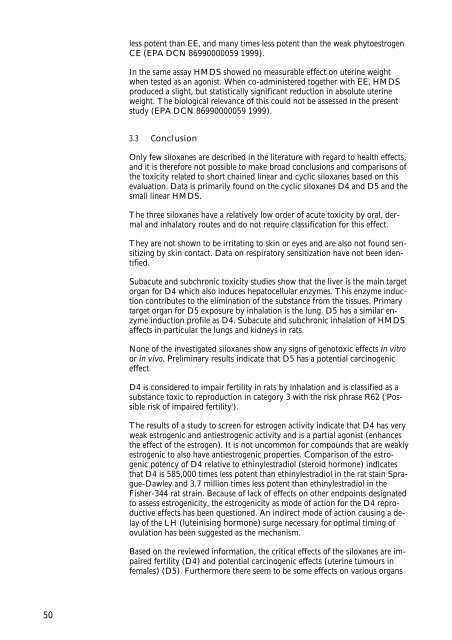Siloxanes - Consumption, Toxicity and Alternatives - Miljøstyrelsen
Siloxanes - Consumption, Toxicity and Alternatives - Miljøstyrelsen
Siloxanes - Consumption, Toxicity and Alternatives - Miljøstyrelsen
You also want an ePaper? Increase the reach of your titles
YUMPU automatically turns print PDFs into web optimized ePapers that Google loves.
50<br />
less potent than EE, <strong>and</strong> many times less potent than the weak phytoestrogen<br />
CE (EPA DCN 86990000059 1999).<br />
In the same assay HMDS showed no measurable effect on uterine weight<br />
when tested as an agonist. When co-administered together with EE, HMDS<br />
produced a slight, but statistically significant reduction in absolute uterine<br />
weight. The biological relevance of this could not be assessed in the present<br />
study (EPA DCN 86990000059 1999).<br />
3.3 Conclusion<br />
Only few siloxanes are described in the literature with regard to health effects,<br />
<strong>and</strong> it is therefore not possible to make broad conclusions <strong>and</strong> comparisons of<br />
the toxicity related to short chained linear <strong>and</strong> cyclic siloxanes based on this<br />
evaluation. Data is primarily found on the cyclic siloxanes D4 <strong>and</strong> D5 <strong>and</strong> the<br />
small linear HMDS.<br />
The three siloxanes have a relatively low order of acute toxicity by oral, dermal<br />
<strong>and</strong> inhalatory routes <strong>and</strong> do not require classification for this effect.<br />
They are not shown to be irritating to skin or eyes <strong>and</strong> are also not found sensitizing<br />
by skin contact. Data on respiratory sensitization have not been identified.<br />
Subacute <strong>and</strong> subchronic toxicity studies show that the liver is the main target<br />
organ for D4 which also induces hepatocellular enzymes. This enzyme induction<br />
contributes to the elimination of the substance from the tissues. Primary<br />
target organ for D5 exposure by inhalation is the lung. D5 has a similar enzyme<br />
induction profile as D4. Subacute <strong>and</strong> subchronic inhalation of HMDS<br />
affects in particular the lungs <strong>and</strong> kidneys in rats.<br />
None of the investigated siloxanes show any signs of genotoxic effects in vitro<br />
or in vivo. Preliminary results indicate that D5 has a potential carcinogenic<br />
effect.<br />
D4 is considered to impair fertility in rats by inhalation <strong>and</strong> is classified as a<br />
substance toxic to reproduction in category 3 with the risk phrase R62 ('Possible<br />
risk of impaired fertility').<br />
The results of a study to screen for estrogen activity indicate that D4 has very<br />
weak estrogenic <strong>and</strong> antiestrogenic activity <strong>and</strong> is a partial agonist (enhances<br />
the effect of the estrogen). It is not uncommon for compounds that are weakly<br />
estrogenic to also have antiestrogenic properties. Comparison of the estrogenic<br />
potency of D4 relative to ethinylestradiol (steroid hormone) indicates<br />
that D4 is 585,000 times less potent than ethinylestradiol in the rat stain Sprague-Dawley<br />
<strong>and</strong> 3.7 million times less potent than ethinylestradiol in the<br />
Fisher-344 rat strain. Because of lack of effects on other endpoints designated<br />
to assess estrogenicity, the estrogenicity as mode of action for the D4 reproductive<br />
effects has been questioned. An indirect mode of action causing a delay<br />
of the LH (luteinising hormone) surge necessary for optimal timing of<br />
ovulation has been suggested as the mechanism.<br />
Based on the reviewed information, the critical effects of the siloxanes are impaired<br />
fertility (D4) <strong>and</strong> potential carcinogenic effects (uterine tumours in<br />
females) (D5). Furthermore there seem to be some effects on various organs

















